Tips of the trade
How to Write a Standout RFP Response
Learn how to craft an RFP response that will catch the requester’s attention and win their business.
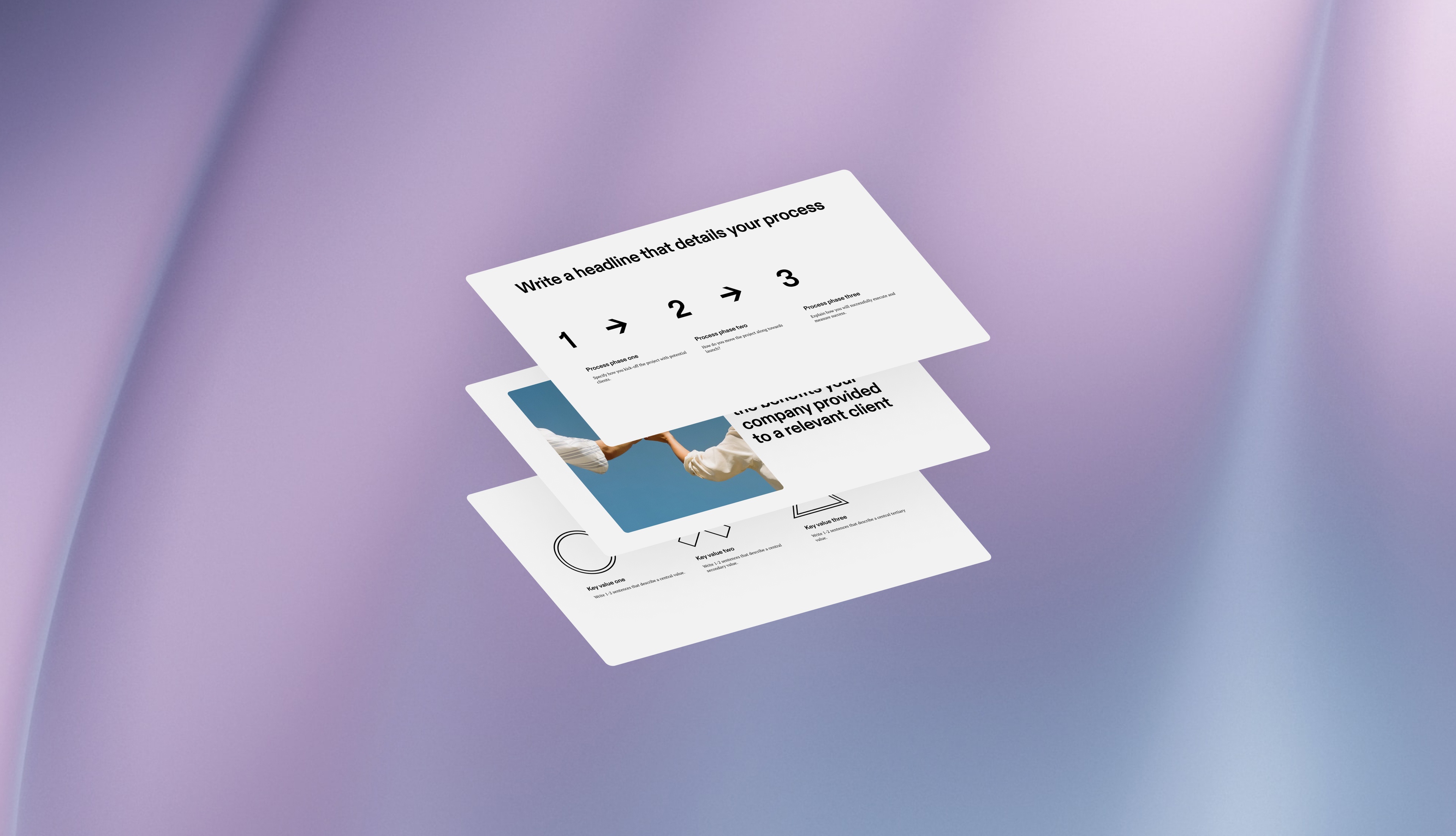
You know your team is great at what you do. You have the chops, the experience, and the enthusiasm. You’re confident you’d deliver great work on a project.
But first, you have to convince the client.
How do you do it? In various industries, companies will issue a Request for Proposal (RFP) when they have a need. It’s a formal document that details their project and invites potential service providers or vendors to submit proposals for solutions.
Winning that business means writing a successful response to the RFP: one that makes your company stand out, shows that you understand the challenge, and highlights why you’re a good fit.
What is an RFP response?
An RFP response is a document that a vendor or service provider prepares in response to an RFP. It’s a comprehensive proposal that outlines how the supplier’s product or service can successfully meet the requester’s needs.
An RFP is a structured way to gather information from various suppliers and compare offerings. Successful RFP responses present information in a corresponding fashion. Typically, they include information like proposed solutions and deliverables, the thinking behind the strategy, pricing, and details about your company including past experience. The ability to effectively write an RFP response is crucial to show you truly understand the client’s needs and can deliver valuable solutions to solve their problem.

How to respond to RFP: outline and sections
A wide variety of sectors use requests for proposals, so projects could include items like software development, marketing services, construction, information technology, website creation, and much more.
While each requester may ask for different types of RFP responses, speaking broadly, many seek similar information and structure. You should expect to include the following nine key sections when responding to an RFP:
- Cover page
- Introductory letter
- Table of contents
- Executive summary
- Solution, process, and deliverables
- Pricing
- References and social proof
- About us
- Appendix
- Terms
1. Cover page
The cover page of your RFP response serves as your first impression. It should reflect your brand identity with your firm’s style, color, and logo, and it should also include the logo of your prospective client.

2. Introductory letter
Just like a cover letter for an individual job application, RFP response cover letters are typically letters addressed to the RFP requester and signed by you.
Successful letters are centered on your potential client: proving that you deeply understand their needs and project requirements, showing your company is experienced and uniquely suited to serve them, and sharing at a high level how you’ll help them reach their goals. Tonally, think friendly, confident, professional, and enthusiastic.
Add your branding—including your company name and logo, as well as your contact information—at the top of this and every page, as requesters are often reading through a stack of responses.
3. Table of contents
Give your reader a very brief overview of the sections to come, including the page numbers, so they can easily navigate the document.
4. Executive summary
Write a concise summary of your RFP response. Successful executive summaries stay focused on the RFP’s specifications, recap the problem your client is trying to solve, highlight the key points of why your company and solution are the best fit for those s needs, and emphasize your unique value proposition. Consider the format, too: bullet points and bold lead-ins allow easy scanning, for example.
5. Solution, process, and deliverables
This is the meat of your RFP response, detailing your approach, specific solutions, process, and deliverables.
First, present your overall approach to the project—the strategy that will guide your execution. What’s the creative through-line or unique lens you’ll bring to the client’s problem? A bold strategy statement can help you differentiate from other RFP respondents.
Next, list your solutions, each under their own header. Depending on the proposal, these header categories might be something like “Phase 1, Phase 2, and Phase 3” for a project that unfolds over time, or “Creative, Email, and Social” for a marketing campaign.
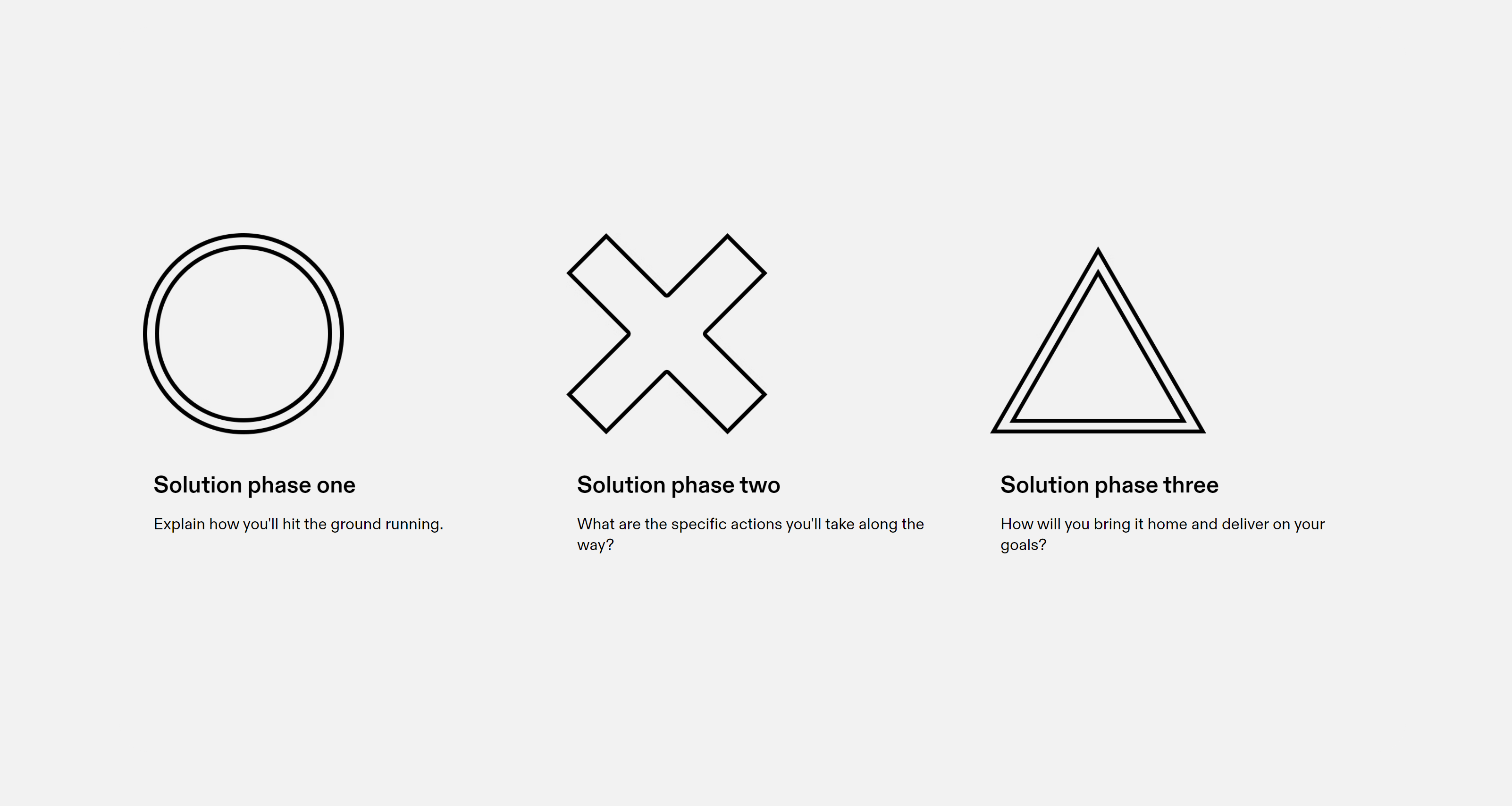
After that, explain your process: Describe what you’ll do as part of each solution, and be sure to explain why and how you believe these actions will help the client solve their problem. Call back to specific verbiage in the RFP as you concisely discuss the benefits and features of your solutions, explaining why they will address the client’s needs. Remember that the focus should always remain on the specifications in the RFP and the prospective client.
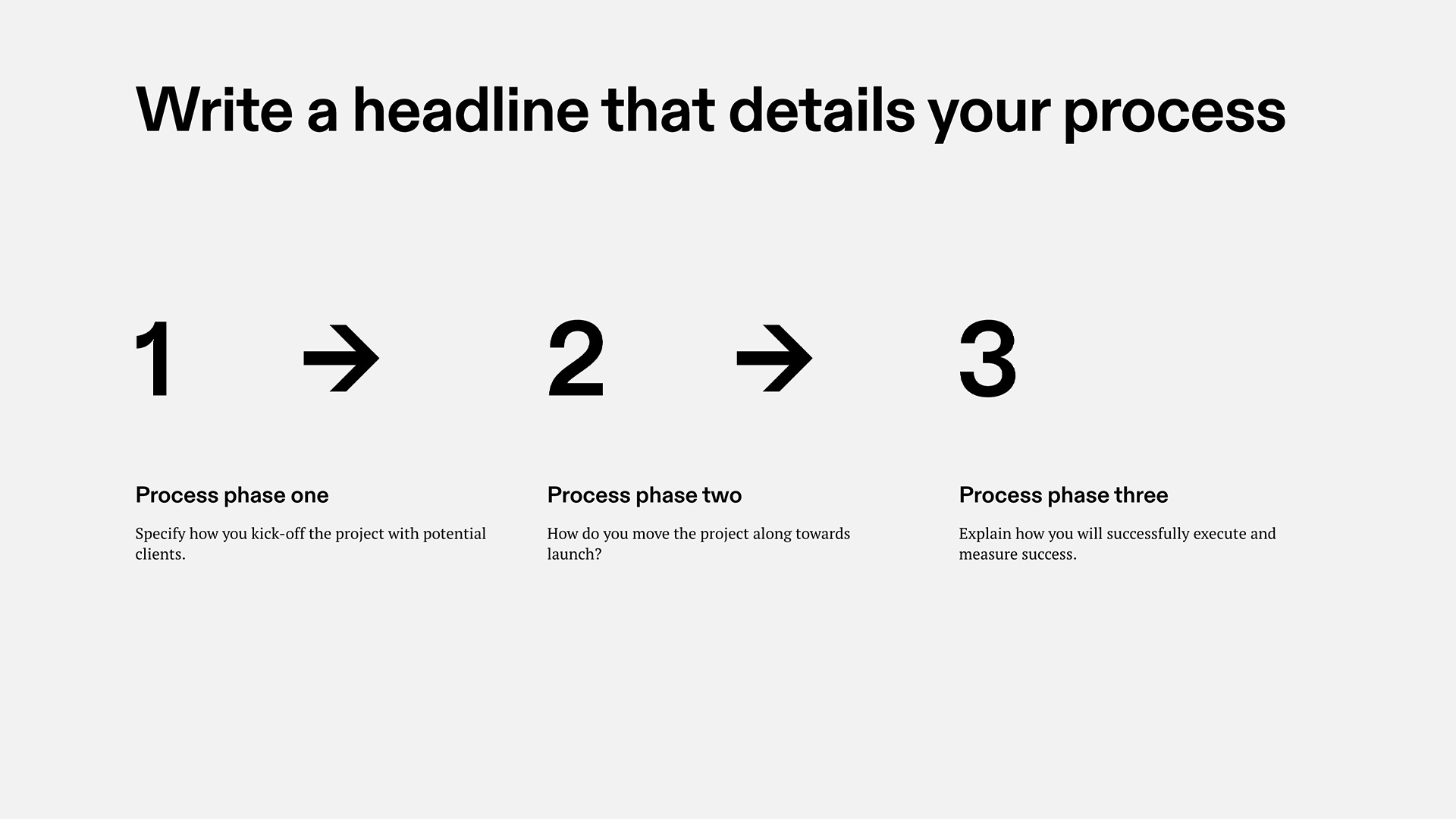
Visuals like charts or mockups can also help illustrate complex ideas. Ideas for visuals include venues or previous setups for event RFPs, mockups for ad-creative RFPs, and type treatments that align with your brand identity and the project’s needs.
Finally, include a list of specific deliverables for each solution. Again here, bullet points or numbered lists are easy to scan—while also making clear what is not included. Depending on the RFP, some companies choose to include information like the start and completion dates for each deliverable, quantity (think X number of social posts), and the team members assigned.
Note: Save pricing details for the next section. Here, you want your reader to remain focused on your compelling strategy—which can help start making the sale before dollar signs even appear.
6. Pricing
By the time your client gets to this section of the proposal, you’ve already explained your strategy and your plan to execute it. Now, explain what it costs.
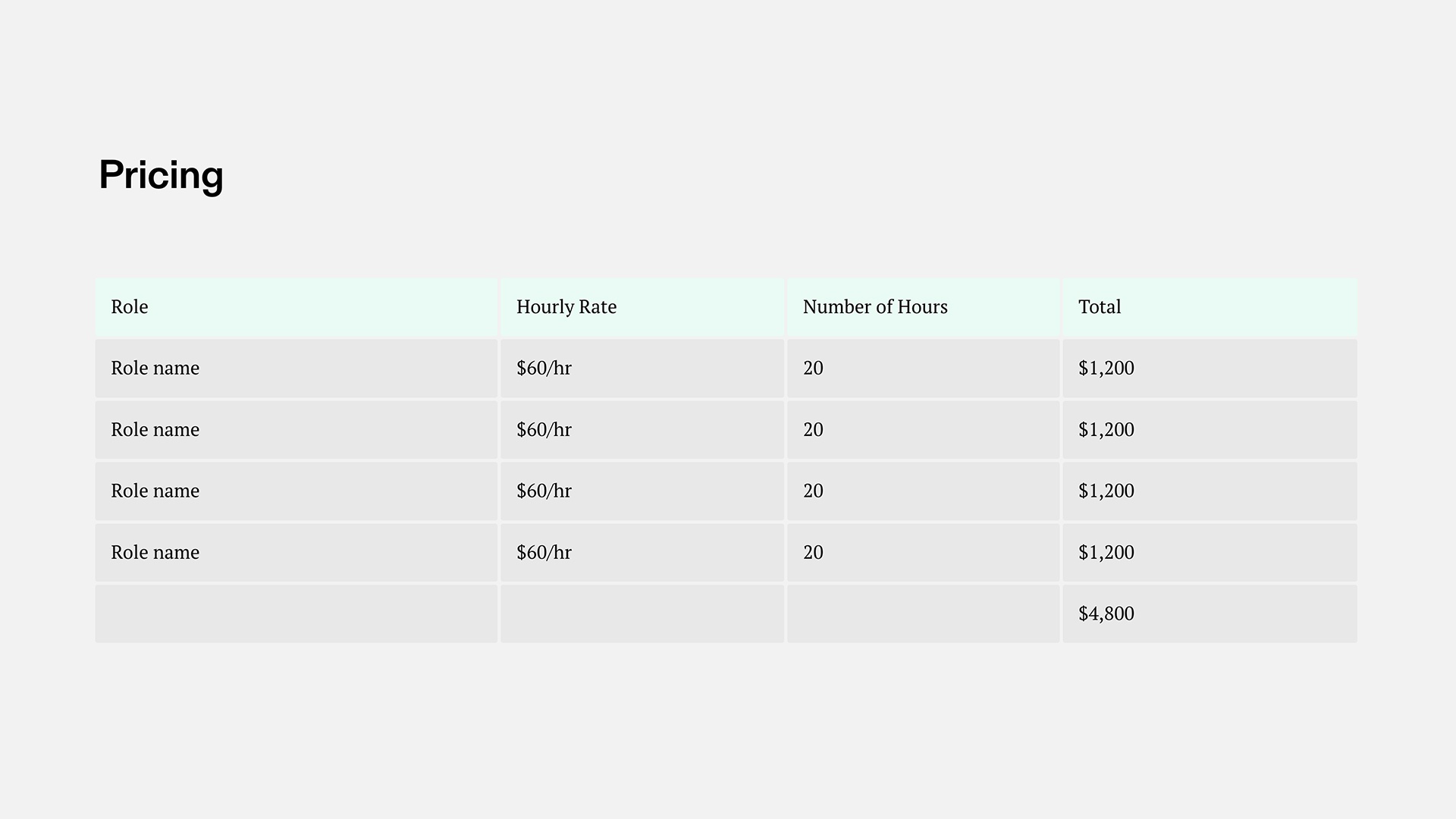
Your pricing section should clearly show the total cost of each solution. Depending on the specifics of the RFP and how you or your company works, you’ll either break that down by deliverable or by time spent.
List each of your solutions and their related deliverables or hours, with the rate and number of units for each. Then, add up the deliverables and provide a total for each solution. At the end, include a grand total for all solutions combined—the full cost of your plan, which should reflect the budget the client provided in the RFP.
Note: Avoid the temptation to offer a slew of plans, combinations, and options. You risk overwhelming the client by putting the onus on them, who is looking to you to present an informed strategy. Go in strong by providing a clear recommendation. Once you’ve attracted the client’s interest, you can make tweaks to solutions or packages later if needed.
7. References and social proof
Including testimonials from past clients enhances your RFP response by providing tangible evidence that the product or service being marketed works effectively in the real world. These testimonials serve as social proof, demonstrating to the prospective client that your solutions have been successful for others and are likely to be successful for them too.
When selecting testimonials to include, opt for ones that are relevant to the project at hand. Highlight specific impressive results and emphasize your clients’ satisfaction with your product or service. Consider including short case studies that showcase notable achievements and illustrate how your company’s solutions have addressed similar challenges faced by the prospective client.
While some companies choose to include this section earlier in their RFP responses, placing it towards the end allows you to focus first on demonstrating how your company can help the client. This approach gives you the opportunity to go into more detail about your successful track record and the benefits of working with your company after you’ve garnered interest based on your proposed strategy.
8. About us
In this section, you’ll highlight your qualifications, philosophy, and relevant experience. Describe how your experience and skills directly relate to the project’s requirements and the client’s needs.
Start by briefly highlighting why your company’s unique benefits and solutions make you the right choice.

You may also include references, testimonials, or short case studies that underscore your company's successful track record. Choose clients and studies that are relevant to this project, and highlight specific impressive results as well as your clients’ satisfaction. Some companies also include brief bios for each team member who will be involved, which is an elegant way to name-drop previous clients and success stories throughout their careers.
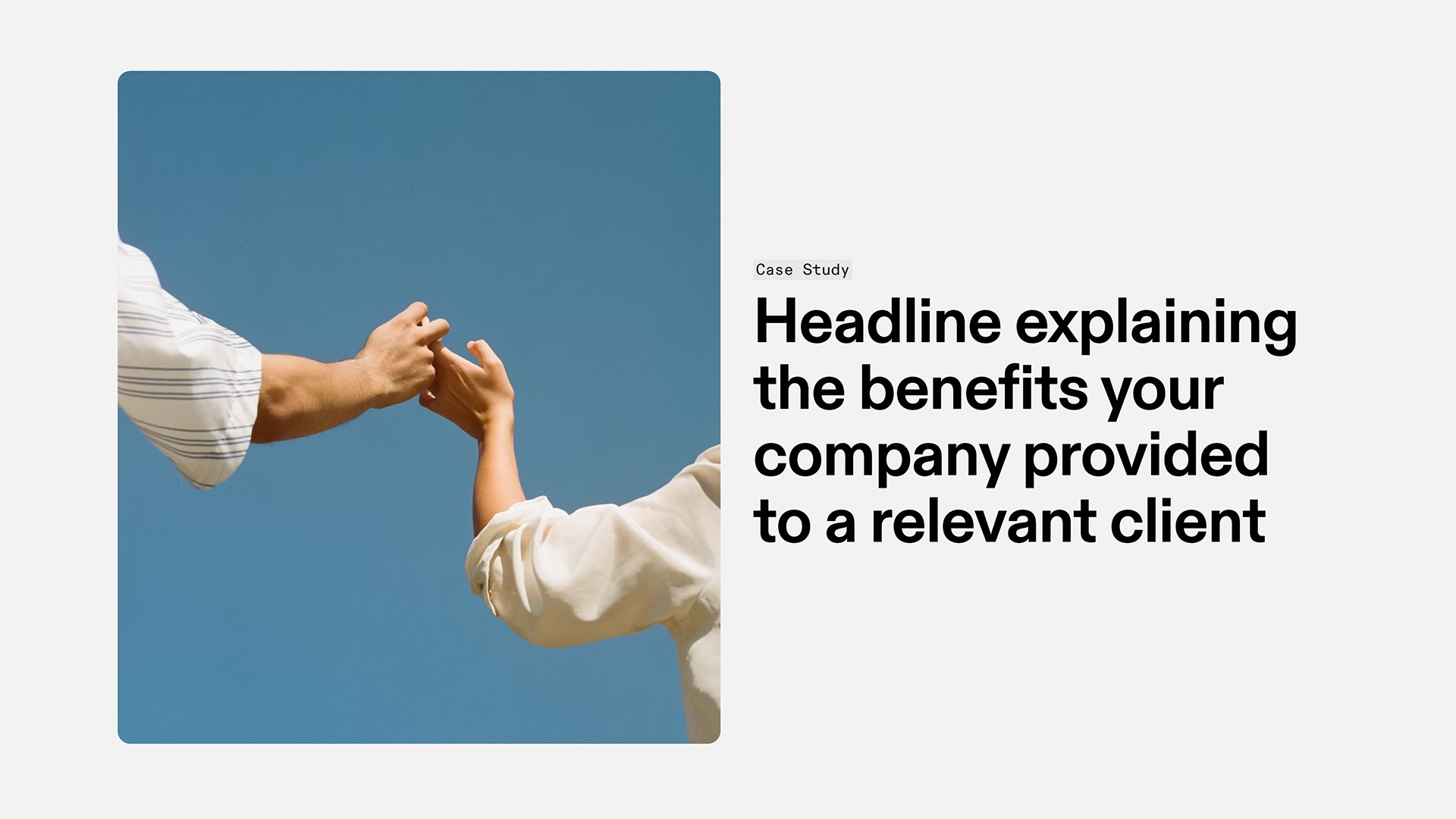
While some companies include this section earlier in their RFP responses, others prefer to focus first on how they can help the client—and go into more detail later once they’ve garnered interest based on their strategy. By placing this section at the end, you may give yourself a bit more space for information like case studies and team bios—rather than rushing through to get to the meat of your proposal.
9. Appendix (i.e. compliance statement, licenses, and any other related extras)
If needed, an appendix can serve as a sort of “miscellaneous” section. Depending on the type of RFP, some responses may require you to include proof of certifications, licenses, or other technical specifications. Others may benefit from inclusion of compliance statements around items like cybersecurity or personally identifiable information.
Avoid the temptation of going too long with the appendix, as it shouldn’t include any extraneous information. It simply serves as a catchall bucket for required or relevant information that doesn’t easily fit elsewhere.
10. Terms
After reading your compelling proposal, your reader may be ready to become your client. You may choose to include your boilerplate terms and conditions (which should align with industry standards and remain fair to both parties). In addition to project deliverables, pricing and scope, these terms may also include information about warranties, intellectual property, dispute resolution, and more.
5 tips for writing a winning RFP response
While every RFP is different, there are several “rules” that apply to writing successful responses. Here, two experts share their dos and don’ts.
1. Qualify the opportunity
Before crafting an RFP response, it’s crucial to ensure that your company qualifies for the deal being offered. While it can be tempting to pursue every opportunity that comes your way, investing time and resources into RFP responses for deals you’re unlikely to win can hinder your success rate.
Qualifying the opportunity means asking yourself: Does this deal align with our expertise, resources, and capabilities? Is the scope of work within our wheelhouse?
By taking the time to assess whether the opportunity is a good fit for your company, you can focus your efforts on pursuing deals where you have a competitive advantage and are more likely to succeed. This strategic approach not only maximizes your chances of winning but also ensures that you allocate your resources effectively.
2. Read the RFP very carefully, multiple times.
Quality RFP responses take work, and it would be a shame for your firm to be thrown into the “toss” pile because you missed a simple requirement.
“The good thing about RFPs is that they are generally extremely prescriptive—so the RFP will often tell you exactly how they would like you to structure your response and what to include,” says Anjie Zheng, Managing Editor of Strategic Proposals at a transit technology company.
That prescriptiveness is helpful—and consider it a mandate, not a friendly suggestion. If you fail to include requirements stated in the RFP, the requester may simply disqualify you in favor of other hopeful vendors who followed the directions.
“Read through the RFP several times, very carefully, to make sure you’ve checked every box,” Zheng says.
3. If you’re not sure, ask.
Still unclear on a point or two, even after multiple careful reads of the RFP? Don’t be afraid to ask one round of questions, says Michael Steele, Founder and CEO of technical marketing agency, Flywheel Digital.
“Don’t overwhelm the client, but it’s perfectly fine to get clarity on a few things to make sure you’re not leaving anything to chance,” Steele says. “If you do one thing and they meant another, you’re dead in the water. And if they balk at responding to questions or don’t give you helpful answers, it's a good indicator that they probably already have a specific vendor in mind anyway.”
“If you do one thing and they meant another, you’re dead in the water. And if they balk at responding to questions or don’t give you helpful answers, it's a good indicator that they probably already have a specific vendor in mind anyway.”


4. Use visuals and compelling language to keep your reader interested.
RFP responses tell a story, and you should avail yourself of any tactics you’d use in other formats to tell a good story.
“Think about RFP writing as you would think of any piece of content. Who's your target audience and what do they care about?” Zheng says. “Try to speak to them specifically by including information that you believe will be helpful and a tone of voice that’s appropriate.”
Think beyond text, too, she adds. Use diagrams, graphics, and other visuals to break up the text and draw your reader in—because giant, uninterrupted blocks of text can make a reader’s eyes glaze over.
5. Stay at the right altitude.
The requester wants to understand your company’s approach and why you’re the right vendor for the job. Yes, you should describe your strategies—but there’s no need to dive into the minutiae. In fact, getting too detailed in your response could hurt you.
“You run the risk of one person reading it and saying, ‘Oh, I don’t like that particular plugin, so maybe they’re not a good fit,’” Steele says. “People get caught up in those details sometimes, even though they’re easily changed. So stay focused on the overall picture: your approach and why you're the right partner.”
RFP response example
Let's dive into an illustrative example of a winning RFP response using the recommended outline in the Tome RFP response template. This template not only guides you through each step of the proposal process but also serves as a prime example of how to structure your response effectively.
Cover Letter
[Your Company Logo]
[Your Company Name]
[Your Company Address]
[City, State, ZIP Code]
[Phone Number]
[Email Address]
[Website]
[Client's Company Logo]
[Client's Company Name]
[Client's Address]
[City, State, ZIP Code]
[Contact Person's Name]
[Contact Person's Title]
[Contact Person's Email Address]
[Date]
Dear [Client's Name],
We are thrilled to submit our proposal in response to your request for [specific project or service] outlined in your recent RFP. At [Your Company Name], we are committed to delivering innovative solutions that exceed our clients' expectations and drive tangible results. With our extensive experience in [industry/sector], we are confident in our ability to address your unique needs and objectives.
Executive Summary
Our proposed solution aims to [brief overview of proposed solution]. By leveraging our [unique approach/methodology], we will [key benefits/outcomes]. With a focus on [client's specific goals], our comprehensive strategy is designed to deliver measurable results and propel your organization forward.
Solution Overview
Phase 1: Discovery and Analysis
- Conduct thorough market research and analysis to identify key opportunities and challenges.
- Engage stakeholders to gather insights and align project objectives with organizational goals.
Phase 2: Strategy Development
- Develop a customized strategy tailored to address the client's specific needs and objectives.
- Collaborate with internal and external stakeholders to refine the strategy and ensure alignment with best practices and industry standards.
Phase 3: Implementation and Execution
- Execute the strategy with precision and efficiency, leveraging cutting-edge tools and technologies.
- Monitor progress and make adjustments as necessary to optimize performance and achieve desired outcomes.
Case Studies and Testimonials
Client Success Story: [Client Name]
Challenge: [Brief Description of Client's Challenge]
Solution: [Description of Solution Implemented]
Results: [Quantifiable Results Achieved]
Testimonial: "[Client Testimonial]"
Project Timeline and Deliverables
Phase 1: Discovery and Analysis (Month 1-2)
- Conduct market research and analysis
- Stakeholder engagement sessions
- Deliverable: Market research report
Phase 2: Strategy Development (Month 3-4)
- Strategy brainstorming sessions
- Strategy refinement workshops
- Deliverable: Comprehensive strategy document
Phase 3: Implementation and Execution (Month 5-6)
- Execution of strategy
- Performance monitoring and optimization
- Deliverable: Implementation report
Team and Expertise
Our dedicated team of experts brings a wealth of experience and expertise to this project:
[Team Member 1]: Project Manager - [Brief Bio/Experience]
[Team Member 2]: Strategy Consultant - [Brief Bio/Experience]
[Team Member 3]: Implementation Specialist - [Brief Bio/Experience]
Pricing and Budget
Total Project Cost: $XX,XXX
Phase 1: Discovery and Analysis - $X,XXX
Phase 2: Strategy Development - $X,XXX
Phase 3: Implementation and Execution - $X,XXX
Conclusion
Thank you for considering [Your Company Name] for this opportunity. We believe that our tailored approach, experienced team, and proven track record make us the ideal partner for [client's project or service]. We are eager to discuss our proposal further and explore how we can contribute to the success of your organization.
By utilizing the RFP response template as a guiding example, you can create a persuasive and well-structured proposal that effectively addresses the client's needs and positions your company as the ideal choice for the project.
Using Tome to create RFP responses
Your style is dynamic—and your RFP responses should be, too. Tome’s impressive RFP response template is designed to spotlight the solutions you bring, and is easily customizable to fit your unique business.
Additionally, Tome’s generative AI helps you get to a first draft faster—create pages, text blocks, and visuals in seconds with prompts. Get a result that’s optimized for any screen size and immersive like an Instagram Story. Explore more of Tome's features and sign up for free.

Submit bids faster and help prospects see why you’re the right business choice.
You may also like...
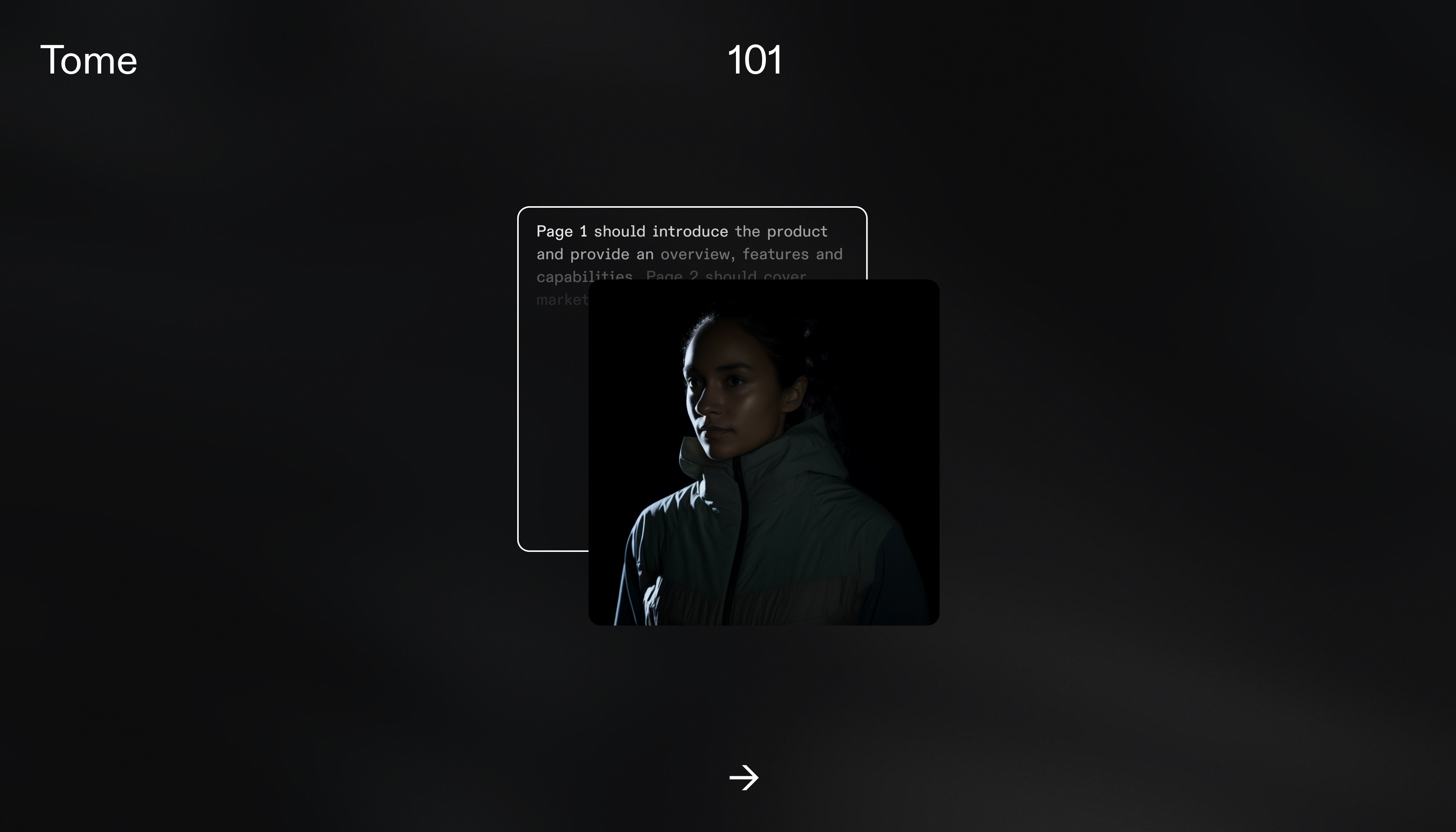
All the tips, templates and AI thought-starters that founders and entrepreneurs need to grow their business with Tome.
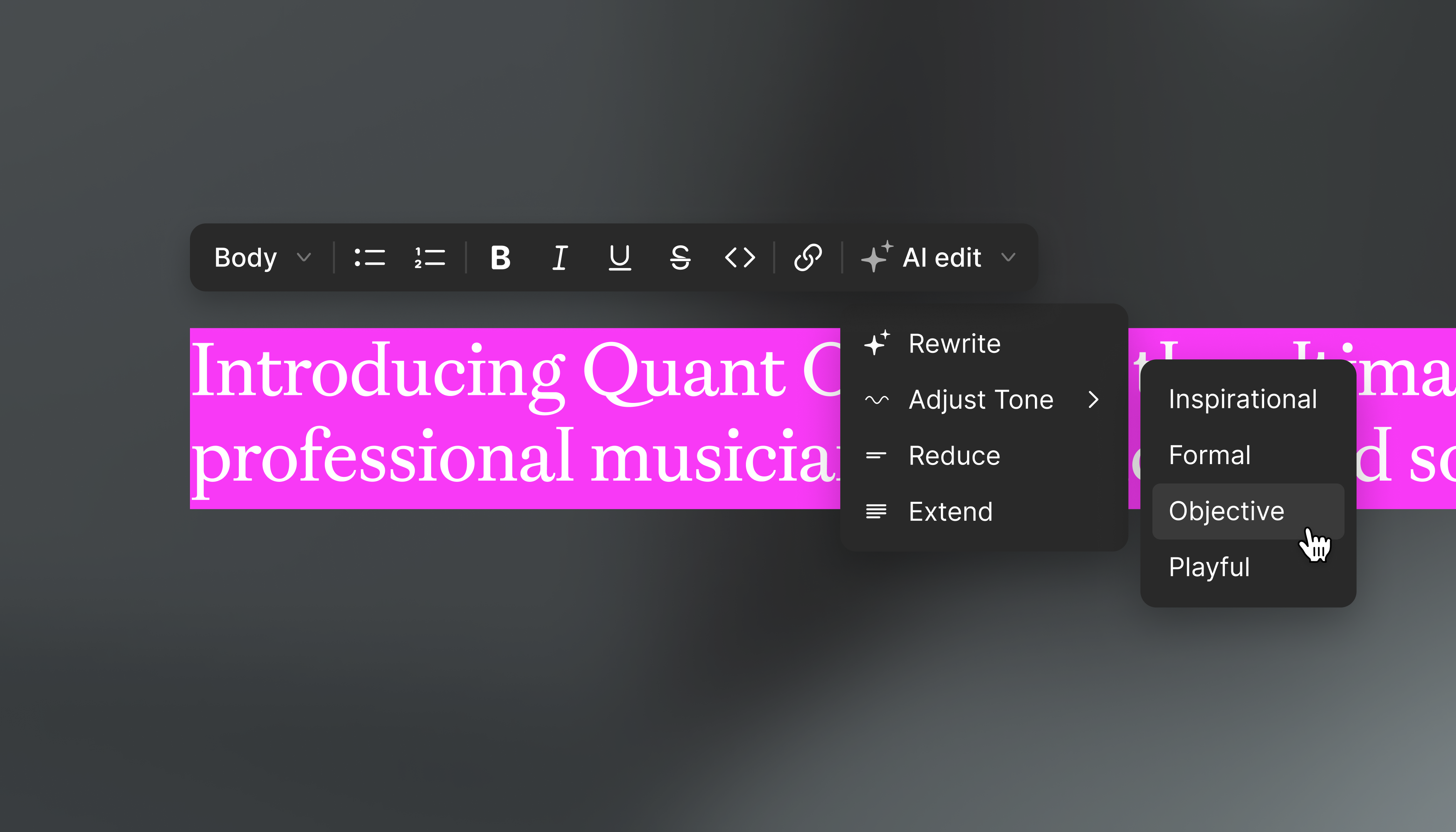
Three popular ways to use AI in sales training, including materials creation, role-playing, and personalized coaching.